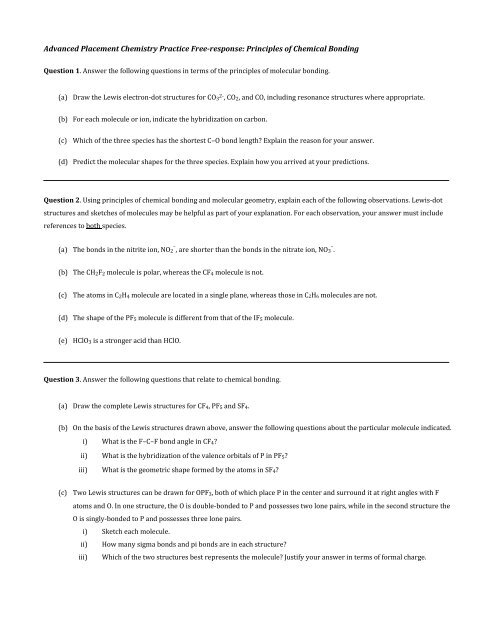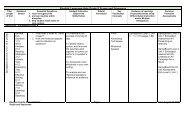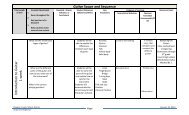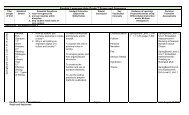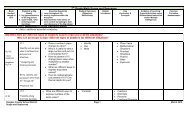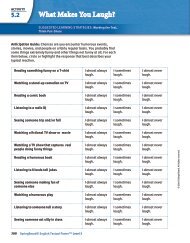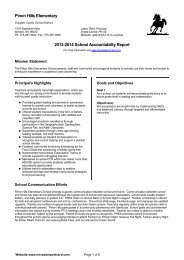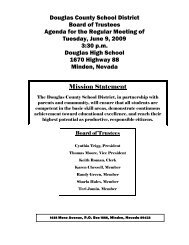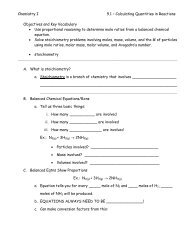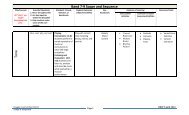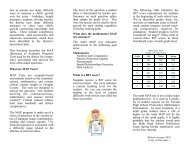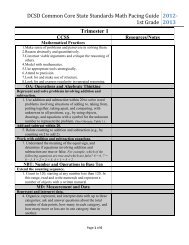Chemical Bonding Review PDF
Chemical Bonding Review PDF
Chemical Bonding Review PDF
You also want an ePaper? Increase the reach of your titles
YUMPU automatically turns print PDFs into web optimized ePapers that Google loves.
Advanced Placement Chemistry Practice Free-response: Principles of <strong>Chemical</strong> <strong>Bonding</strong>Question 1. Answer the following questions in terms of the principles of molecular bonding.(a) Draw the Lewis electron-dot structures for CO 3 2- , CO 2, and CO, including resonance structures where appropriate.(b) For each molecule or ion, indicate the hybridization on carbon.(c) Which of the three species has the shortest C–O bond length? Explain the reason for your answer.(d) Predict the molecular shapes for the three species. Explain how you arrived at your predictions.Question 2. Using principles of chemical bonding and molecular geometry, explain each of the following observations. Lewis-dotstructures and sketches of molecules may be helpful as part of your explanation. For each observation, your answer must includereferences to both species.(a) The bonds in the nitrite ion, NO 2 – , are shorter than the bonds in the nitrate ion, NO 3 – .(b) The CH 2F 2 molecule is polar, whereas the CF 4 molecule is not.(c) The atoms in C 2H 4 molecule are located in a single plane, whereas those in C2H6 molecules are not.(d) The shape of the PF 5 molecule is different from that of the IF 5 molecule.(e) HClO 3 is a stronger acid than HClO.Question 3. Answer the following questions that relate to chemical bonding.(a) Draw the complete Lewis structures for CF 4, PF 5 and SF 4.(b) On the basis of the Lewis structures drawn above, answer the following questions about the particular molecule indicated.i) What is the F–C–F bond angle in CF 4?ii) What is the hybridization of the valence orbitals of P in PF 5?iii) What is the geometric shape formed by the atoms in SF 4?(c) Two Lewis structures can be drawn for OPF 3, both of which place P in the center and surround it at right angles with Fatoms and O. In one structure, the O is double-bonded to P and possesses two lone pairs, while in the second structure theO is singly-bonded to P and possesses three lone pairs.i) Sketch each molecule.ii) How many sigma bonds and pi bonds are in each structure?iii) Which of the two structures best represents the molecule? Justify your answer in terms of formal charge.
Question 4. Answer the following questions about the structure of ions that only contain sulfur and fluorine.(a) The compounds SF 4 and BF 3 react to form an ionic compound according to the following equation.SF 4 + BF 3 → SF 3BF 4i) Draw a complete Lewis structure for the SF 3 + cation in the SF 3BF 4.ii)iii)iv)Identify the type of hybridization exhibited by sulfur in the SF + 3 cation.Identify the geometry of the SF + 3 cation that is consistent with the Lewis structure drawn in part (a)(i).Predict whether the F―S―F bond angle in the SF + 3 cation is larger than, equal to or smaller than 109.5°. Justifyyour answer.(b) The compounds SF 4 and CsF react to form an ionic compound according to the following equation.SF 4 + CsF → CsSF 5i) Draw a complete Lewis structure for the SF – 5 anion in CsSF 5.ii) Identify the type of hybridization exhibited by sulfur in the SF – 5 anion in CsSF 5.iii) Identify the geometry of the SF – 5 anion that is consistent with the Lewis structure drawn in part (b)(i).iv) Identify the oxidation number of sulfur in the compound CsSF 5.GeCl 4 SeCl 4 ICl 4–ICl 4+Question 5. The species represented above all have the same number of chlorine atoms attached to the central atom.(a) Draw the Lewis structure of each of the four species. Show all valence electrons in your structures.(b) On the basis of the Lewis structures drawn in part (a), answer the following questions about the particular speciesindicated.i) What is the Cl―Ge―Cl bond angle in GeCl 4?ii)Is SeCl 4 polar? Explain.iii) What is the hybridization of the I atom in ICl 4 – ?iv) What is the geometric shape formed by the atoms in ICl 4 + ?Question 6. Answer the following questions about ionic compounds and ions.(a) Identify the compound with the greatest lattice energy in each pair. Justify each choice.i) MgO and Na 2Oii) MgO and Ba 2O(b) The ions of phosphorus and sulfur are isoelectronic with one another.i) Identify the number of electrons on the ions.ii) Which of the ions is smaller? Justify your choice.


